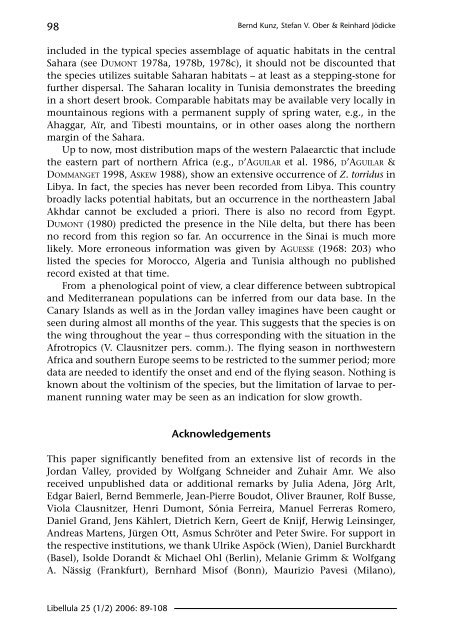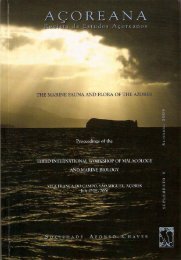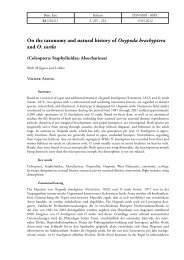The distribution of Zygonyx torridus in the Palaearctic (Odonata ...
The distribution of Zygonyx torridus in the Palaearctic (Odonata ...
The distribution of Zygonyx torridus in the Palaearctic (Odonata ...
You also want an ePaper? Increase the reach of your titles
YUMPU automatically turns print PDFs into web optimized ePapers that Google loves.
98<br />
Libellula 25 (1/2) 2006: 89-108<br />
Bernd Kunz, Stefan V. Ober & Re<strong>in</strong>hard Jödicke<br />
<strong>in</strong>cluded <strong>in</strong> <strong>the</strong> typical species assemblage <strong>of</strong> aquatic habitats <strong>in</strong> <strong>the</strong> central<br />
Sahara (see DUMONT 1978a, 1978b, 1978c), it should not be discounted that<br />
<strong>the</strong> species utilizes suitable Saharan habitats – at least as a stepp<strong>in</strong>g-stone for<br />
fur<strong>the</strong>r dispersal. <strong>The</strong> Saharan locality <strong>in</strong> Tunisia demonstrates <strong>the</strong> breed<strong>in</strong>g<br />
<strong>in</strong> a short desert brook. Comparable habitats may be available very locally <strong>in</strong><br />
mounta<strong>in</strong>ous regions with a permanent supply <strong>of</strong> spr<strong>in</strong>g water, e.g., <strong>in</strong> <strong>the</strong><br />
Ahaggar, Aïr, and Tibesti mounta<strong>in</strong>s, or <strong>in</strong> o<strong>the</strong>r oases along <strong>the</strong> nor<strong>the</strong>rn<br />
marg<strong>in</strong> <strong>of</strong> <strong>the</strong> Sahara.<br />
Up to now, most <strong>distribution</strong> maps <strong>of</strong> <strong>the</strong> western <strong>Palaearctic</strong> that <strong>in</strong>clude<br />
<strong>the</strong> eastern part <strong>of</strong> nor<strong>the</strong>rn Africa (e.g., D’AGUILAR et al. 1986, D’AGUILAR &<br />
DOMMANGET 1998, ASKEW 1988), show an extensive occurrence <strong>of</strong> Z. <strong>torridus</strong> <strong>in</strong><br />
Libya. In fact, <strong>the</strong> species has never been recorded from Libya. This country<br />
broadly lacks potential habitats, but an occurrence <strong>in</strong> <strong>the</strong> nor<strong>the</strong>astern Jabal<br />
Akhdar cannot be excluded a priori. <strong>The</strong>re is also no record from Egypt.<br />
DUMONT (1980) predicted <strong>the</strong> presence <strong>in</strong> <strong>the</strong> Nile delta, but <strong>the</strong>re has been<br />
no record from this region so far. An occurrence <strong>in</strong> <strong>the</strong> S<strong>in</strong>ai is much more<br />
likely. More erroneous <strong>in</strong>formation was given by AGUESSE (1968: 203) who<br />
listed <strong>the</strong> species for Morocco, Algeria and Tunisia although no published<br />
record existed at that time.<br />
From a phenological po<strong>in</strong>t <strong>of</strong> view, a clear difference between subtropical<br />
and Mediterranean populations can be <strong>in</strong>ferred from our data base. In <strong>the</strong><br />
Canary Islands as well as <strong>in</strong> <strong>the</strong> Jordan valley imag<strong>in</strong>es have been caught or<br />
seen dur<strong>in</strong>g almost all months <strong>of</strong> <strong>the</strong> year. This suggests that <strong>the</strong> species is on<br />
<strong>the</strong> w<strong>in</strong>g throughout <strong>the</strong> year – thus correspond<strong>in</strong>g with <strong>the</strong> situation <strong>in</strong> <strong>the</strong><br />
Afrotropics (V. Clausnitzer pers. comm.). <strong>The</strong> fly<strong>in</strong>g season <strong>in</strong> northwestern<br />
Africa and sou<strong>the</strong>rn Europe seems to be restricted to <strong>the</strong> summer period; more<br />
data are needed to identify <strong>the</strong> onset and end <strong>of</strong> <strong>the</strong> fly<strong>in</strong>g season. Noth<strong>in</strong>g is<br />
known about <strong>the</strong> volt<strong>in</strong>ism <strong>of</strong> <strong>the</strong> species, but <strong>the</strong> limitation <strong>of</strong> larvae to permanent<br />
runn<strong>in</strong>g water may be seen as an <strong>in</strong>dication for slow growth.<br />
Acknowledgements<br />
This paper significantly benefited from an extensive list <strong>of</strong> records <strong>in</strong> <strong>the</strong><br />
Jordan Valley, provided by Wolfgang Schneider and Zuhair Amr. We also<br />
received unpublished data or additional remarks by Julia Adena, Jörg Arlt,<br />
Edgar Baierl, Bernd Bemmerle, Jean-Pierre Boudot, Oliver Brauner, Rolf Busse,<br />
Viola Clausnitzer, Henri Dumont, Sónia Ferreira, Manuel Ferreras Romero,<br />
Daniel Grand, Jens Kählert, Dietrich Kern, Geert de Knijf, Herwig Le<strong>in</strong>s<strong>in</strong>ger,<br />
Andreas Martens, Jürgen Ott, Asmus Schröter and Peter Swire. For support <strong>in</strong><br />
<strong>the</strong> respective <strong>in</strong>stitutions, we thank Ulrike Aspöck (Wien), Daniel Burckhardt<br />
(Basel), Isolde Dorandt & Michael Ohl (Berl<strong>in</strong>), Melanie Grimm & Wolfgang<br />
A. Nässig (Frankfurt), Bernhard Mis<strong>of</strong> (Bonn), Maurizio Pavesi (Milano),
















